Before XCMG ChuSheng Original, we made a systematic introduction to natural gas products, including the introduction of natural gas products such as Weichai, Xichai, and CNHTC. Among them, the working principle of the system structure of natural gas engine products is basically the same. Today, the online search of Yuchai natural gas engine products was once again organized and shared for everyone's reference. Detailed information is subject to the official website announcement.
â— Â CNG Engine ECI EPR System Principle
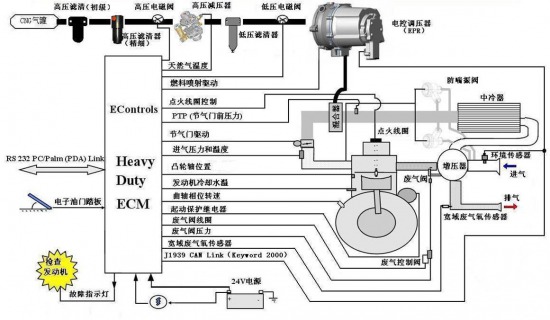
Turbocharged CNG engine working principle diagram

Naturally aspirated CNG engine working principle diagram
From the CNG engine working principle diagram, the basic principle of the engine is:
The high-pressure compressed natural gas comes out of the gas storage cylinders, is filtered by the natural gas filter, passes through the high-pressure solenoid valve and enters the high-pressure pressure reducer, the opening and closing of the high-pressure electromagnetic valve is controlled by the ECM, and the role of the high pressure pressure reducer is to compress high pressure compressed natural gas. (Operating pressure 200bar-30bar) Heating under reduced pressure adjusts the pressure to 7bar-9bar. High-pressure natural gas needs to absorb a large amount of heat due to decompression and expansion during depressurization. In order to prevent the decompressor from freezing, the engine coolant is drawn from the engine to a pressure reducer to heat the gas.
The decompressed natural gas enters the electronically controlled pressure regulator. The role of the electronically controlled pressure regulator is to precisely control the natural gas injection amount according to the operating conditions of the engine. Natural gas and air are fully mixed in the mixer, enter the engine cylinder, and ignited by a spark plug. The ignition timing of the spark plug is controlled by the ECM. The oxygen sensor immediately monitors the oxygen concentration of the exhaust gas after combustion, and the air fuel ratio is calculated. The ECM is based on the oxygen sensor. The feedback signal and control MAP timely correct the natural gas injection amount.
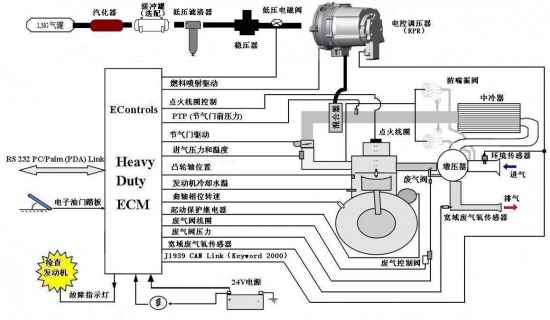
Pressurized LNG engine working principle diagram
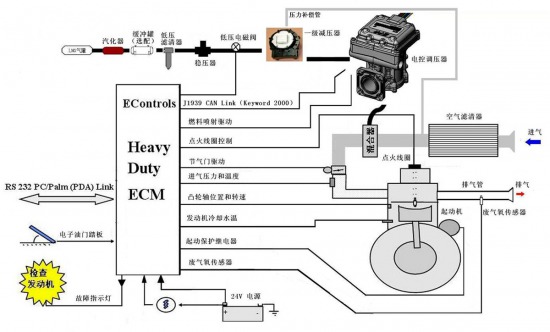
Natural suction LNG engine working principle diagram
â— Â Electronically controlled engine working principle
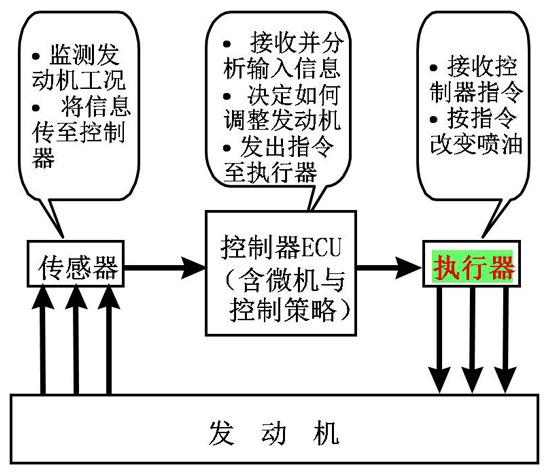
Conceptual diagram of engine electronic control system
â— Â Natural gas engine control system

Natural gas engine control system
The main structure of natural gas engine includes: 1, fuel supply system, 2, ignition system, 3, boost pressure control system, 4, sensor, 5, electronic control module. The following gives you a brief introduction to the characteristics of these major component structures. Among other things, the fuel supply system includes a high pressure fuel shut-off valve component, a high pressure reducer, a low pressure solenoid valve component, an electronically controlled pressure regulator component (EPR valve), a mixer component, and an electronic throttle.
â— Â Fuel Supply System: Six Major Components

 1. High Pressure Fuel Shutoff Valve Parts: Cut off or restore fuel supply in time
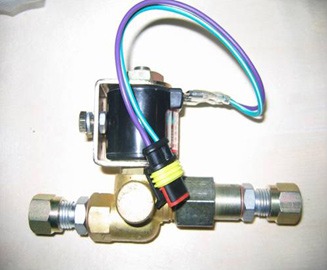
 Working principle: The spool is driven by the coil, the opening and closing are controlled by the ECM, and it is normally closed under the stop state.
 Role: To cut off or restore fuel supply in a timely manner.
 Installation requirements: To effectively prevent the leakage of the high-pressure solenoid valve inlet joint and the high-pressure solenoid valve at the joint, a thread sealant (such as Loctite 262) must be used when the joint is installed, and the joint is locked to make the copper pad deform slightly. seal.
 maintenance:
(1) Cleaning the filter: The inlet port of the high-pressure fuel shut-off valve has its own filter, which can be soaked with gasoline and blown clean with compressed air.
(2) Cleaning the valve core and valve port: If the high-pressure electromagnetic valve filter core is found to be heavily polluted during dismantling, the high-pressure solenoid valve core and valve seat must be removed, soaked in gasoline, and blown clean with compressed air.
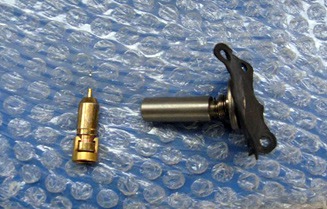
(3) Checking high and low pressure solenoid valves
 2. High pressure regulator: Decompress high pressure compressed natural gas
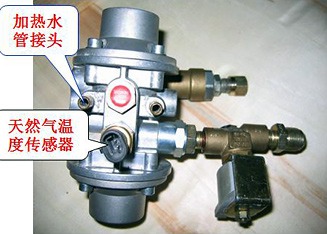
 Working principle: Through the pressure diaphragm to overcome the spring resistance, drive the lever, adjust the flow area of ​​the orifice, and thus control the natural gas pressure after decompression.
 Role: Through the throttling and heating, high-pressure compressed natural gas is decompressed to low pressure natural gas of 7bar-9bar.
 Installation requirements:
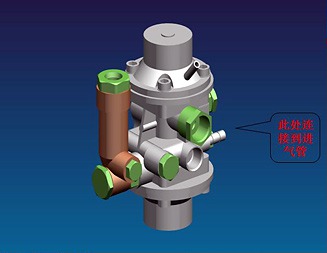
(1) The threaded part of the pressure reducer inlet joint must use a thread sealant and be sealed with a copper pad.
(2) The pressure reducer outlet fitting is sealed with an O-ring. The outlet fitting and the low pressure solenoid valve, the low pressure solenoid valve and the solenoid valve outlet fitting are connected by taper threads. The installation must use thread sealant.
(3) The high-pressure reducer communicates with the engine's cooling water circulation water channel through two water pipes. When installing the water pipe, please tighten the hoop to prevent water leakage.
(4) The high pressure reducer must be connected to the intake pipe through a pressure feedback pipe in order to control the regulator outlet pressure according to operating conditions.
(5) The pressure reducing regulator should be installed near the engine intake pipe and in the less vibrating position, but it should not be installed directly on the engine. Therefore, the pressure reducing regulator must be installed on the car (chassis) girder. When designing the pressure reducing regulator bracket, it should be noted that the installation position of the pressure reducing regulator can not be higher than the top of the engine radiator. Otherwise, the heated water cannot flow through the pressure reducer, causing the pressure reducer to freeze and crack.
 maintenance:
(1) Maintenance contents per 50,000 kilometers:
Cleaning: Remove the high-pressure reducer, clean the pressure chamber of the high-pressure reducer with petrol or carburetor cleaning agent, and clean it with dry compressed air;
Replace the valve plug: Remove the high-pressure reducer intake connector, check the filter element is contaminated; if it is contaminated, replace it;
Replace consumables (eg, Rubber seals) and inspect the shaft pin for wear, such as wear and replace the pin. And check and adjust the decompression pressure.
(2) Maintenance contents per 100,000 kilometers:
Replace the diaphragm and seal directly, and check and adjust the decompression pressure.
 3, low pressure solenoid valve components: timely cutting off or restoring fuel supply

 Working principle: The spool is driven by the coil, the opening and closing are controlled by the ECM, and it is normally closed under the stop state.
 Role: To cut off or restore fuel supply in a timely manner.
 Installation requirements:
(1) In order to effectively prevent the leakage of the joint between the high pressure solenoid valve inlet and the high pressure solenoid valve, it must be sealed with a thread sealant (such as Loctite 262) when the joint is installed.
(2) It is required to install the electronically controlled pressure regulator above.
 4, electronically controlled regulator components (EPR valve): control of natural gas injection volume
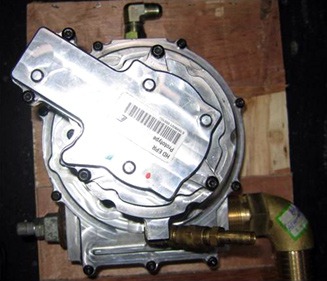
 Working principle: There is a control chip inside the part. The control chip accepts the control instruction from the ECM and controls the gas volume through the high-speed solenoid valve so as to effectively control the air-fuel ratio in real time.
 Role: Control the natural gas injection volume.
 Installation requirements: Due to the control chip inside the part, high-frequency vibration should be avoided. This part comes with shock-absorbing cushions and must not be disassembled. The central level of the outlet of the electronically controlled pressure regulator shall not be lower than the height of the center of the inlet of the mixer. The natural gas outlet of the electronically controlled regulator shall be controlled within 500 mm from the natural gas inlet of the mixer. The purpose is to allow the impurities in natural gas to flow into the mixer as the air enters the cylinder to burn off, keep the EPR valve clean, and keep the natural gas supply response fast.
 Maintenance: The electronically controlled pressure regulator (EPR) requires regular maintenance during use. Because the electronically controlled pressure regulator is in the low-pressure decompression section, it will deposit large amounts of oil and impurities in the interior during long-term use. Time-related oil contamination and impurities can cause poor operation of the electronically controlled regulator, sensor damage, and premature aging and breakage of internal seals and rubber diaphragms. Therefore, maintenance of this component is particularly important.
(1) Every 50,000 kilometers: The internal parts must be cleaned, replacement parts should be replaced, and the wear of the shaft pins must be checked;
(2) Every 150,000 km: Replace the diaphragm and seal, and calibrate the pressure.
 5. Mixer components: Effectively reduce NOx emissions and exhaust temperatures
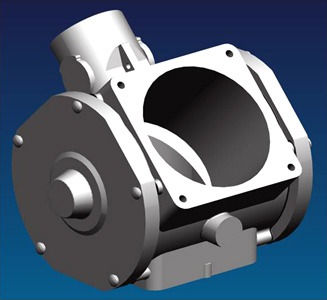
 How it works: The natural gas and the air after the intercooling are fully mixed to make the combustion more fully and soft.
 Role: Effectively reduce NOx emissions and exhaust temperatures.
 Installation requirements: The regulator outlet pipe is installed in the natural gas inlet of the mixer. Taper thread must be installed to prevent air leakage during installation. Mixer gasket I and mixer gasket II are installed on the joint surface of mixer adapter I, mixer adapter II, and mixer. Tighten the bolts to prevent air leakage.
 Maintenance: The E330, E480 mixer has very few moving parts and a sturdy design, so it is very stable. Due to improper use and the influence of cleanliness in the area of ​​use, components in the mixer will also be damaged. According to the investigation and analysis of usage, due to improper use and maintenance of the component, there are two failure modes:
(1) Diaphragm damage: Frequent engine tempering can lead to increased aging of the diaphragm, resulting in cracked and damaged diaphragms.
(2) Stuck fuel air valve: If the compressor oil contained in compressed natural gas is too much and the impurities in the air are not sufficiently filtered, if the inside of the mixer is not cleaned and maintained in time, the oil will adhere to the fuel. Air valve and seat. Accumulation over a long period of time can cause the fuel air valve to be blocked or even completely jammed, leading to unstable engine operation. Therefore, the effect of the air filter on the filtration of natural gas by the air and natural gas filters will directly affect the service life of the mixer.
 6, electronic throttle: control the engine speed and load
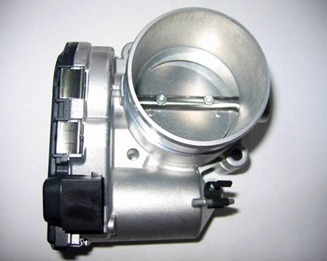
 Working principle and function: By controlling the opening degree of the butterfly valve, the amount of mixed gas entering the cylinder is controlled so as to control the engine speed and load. The driver transmits the power demand to the ECM through the accelerator pedal. After the ECM receives the accelerator pedal signal, the electronic throttle opening is controlled according to the engine operating conditions. By controlling the opening of the butterfly valve, the idle speed and the speed regulation characteristic curve are controlled.
 Installation requirements: When installing the electronic throttle, the axis of the drive motor must remain horizontal.
 maintenance:
(1) Every 100,000 kilometers (depending on local gas cleanliness), remove the throttle valve from the engine and check whether there is obvious oil pollution inside the throttle valve. If so, use throttle valve cleaner to clean the throttle valve. In part, after washing, dry it with dry compressed air.
(2) After cleaning, press the disc valve by hand to check whether the disc valve movement is stuck and whether it is returned. If there is stuck, you need to replace the electronically controlled throttle valve assembly.
â— Â Ignition system: ignition coil and spark plug
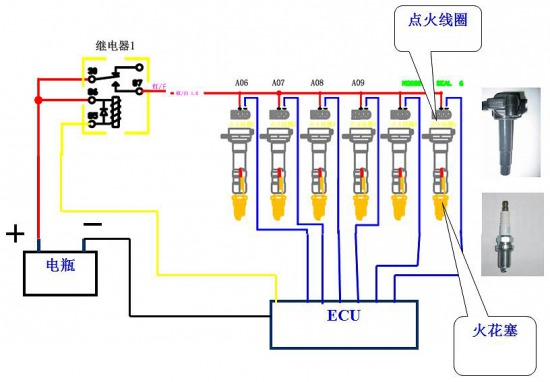
 1. Ignition coil: Make the engine achieve low emission and low gas consumption
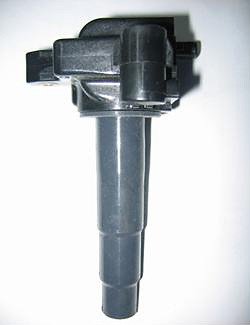
 Role: Receives ECM ignition commands, generates high voltages and passes high voltages to spark plugs, creating sparks and igniting natural gas. The ignition coil can control the ignition timing according to the ECM instruction, so that the engine achieves low emission and low gas consumption.
 Installation requirements: Tighten the ignition coil mounting bolts during installation to ensure that the inner spring of the ignition coil sleeve is in close contact with the spark plug head. Because the high-voltage power supply will generate an arc at the contact surface, the parts of the spring and the head of the spark plug are susceptible to thermal oxidation, resulting in excessive resistance at the contact site. Excessive partial pressure will cause the ignition energy of the spark plug to decrease, and in severe cases it will lead to misfire. Therefore, when installing the spark plug and the ignition coil, the conductive paste must be applied to the joint of the spark plug head and the ignition coil spring. Insulation grease should be applied to the ceramic parts where the rubber sleeve and the spark plug are in contact to prevent leakage between the spark plug and the cylinder head due to aging of the rubber sleeve.
 maintenance:
&, ;nbs, p; (1) The secondary output voltage of the ignition coil is up to 40,000 volts, so during the use of the engine, it is absolutely not allowed to wash the engine directly with water, especially the ignition coil part;
(2) Clean the oxides between the spring and the spark plug every three months or 20,000 kilometers, and apply conductive paste;
(3) Check the ignition coil rubber sleeve for aging cracking every three months. If there is any crack, please replace it in time.
 2, spark plugs:: receive high-voltage sparks, ignite natural gas
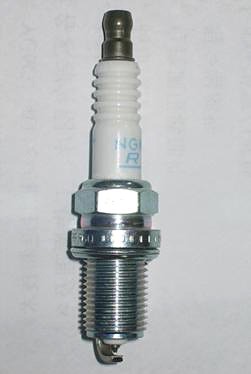
 Role: Receiving high voltage from the ignition coil, creating sparks and igniting natural gas.
 Installation requirements: Tighten the spark plug during installation, tightening torque: 30N.m. A special spark plug bushing must be used to tighten the spark plug. As the high-voltage power supply will generate an arc at the contact surface, the parts in contact with the head of the spark plug will be heated and oxidized, resulting in excessive resistance at the contact part. Excessive partial pressure will lead to lower ignition energy of the spark plug and, in severe cases, will lead to misfire. Therefore, when installing the spark plug and ignition coil, you must apply conductive paste to the spark plug head. Insulation grease should be applied to the ceramic parts where the rubber sleeve and the spark plug are in contact to prevent leakage between the spark plug and the cylinder head due to aging of the rubber sleeve.
 Maintenance: The spark plug is a consumable part. The current spark plug used by Yuchai is NGK platinum and gilded spark plug. The service life of the spark plug is generally 60,000-80,000 kilometers. Its maintenance content is:
(1) Every three months or 20,000 kilometers, it is necessary to check the ignition of the spark plug electrode, clean up the electrode head impurities, and adjust the gap, clearance adjustment requirements are as follows:
Natural gas engine NGK platinum spark plug (PFR7B-D), electrode gap: 0.33+-0.05mm.
Natural gas engine NGK spark plug (IFR7F-4D), electrode gap: 0.4+-0.05mm.
LPG engine NGK spark plug (BKR6EIX), electrode gap: 0.45+-0.05mm.
(2) For every 6-80,000 kilometers, inspect the ablation condition of the precious metal on the spark plug head electrode. If the use condition is good, the gap can be used after adjusting the gap. 80,000 kilometers after the direct replacement of the spark plug, you must use Yuchai specified spark plug, otherwise it may lead to hot ignition, power decline, gas consumption, ignition coil breakdown and other failures.
â— Â Inlet pressure control system: wastegate control valve and anti-surge valve
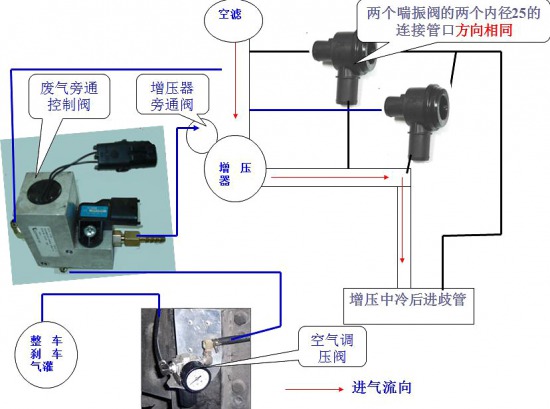
 1, wastegate control valve: can effectively improve the engine low speed torque
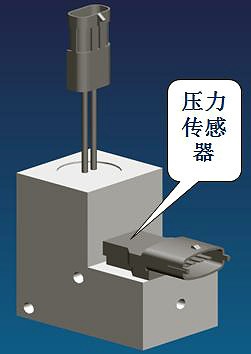

Wastegate control valve schematic
 Working principle: By controlling the duty cycle of the wastegate control valve, the outlet pressure of the wastegate control valve is controlled to control the engine boost pressure.
 Role: Using this technology can effectively improve the engine's low-speed torque and meet the bus's frequent start-up work requirements.
 Installation requirements: Install in a low temperature area with good heat dissipation conditions to ensure component reliability.
 2, anti-surge valve: to avoid supercharger surge, protect the turbocharger
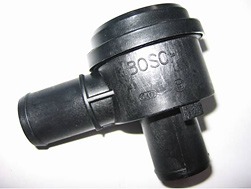
Knitting Machine,Weaving Machine,Machinery For Garment,Textile Machinery Parts
Knitting Machine Co., Ltd , http://www.nbknittingmachine.com